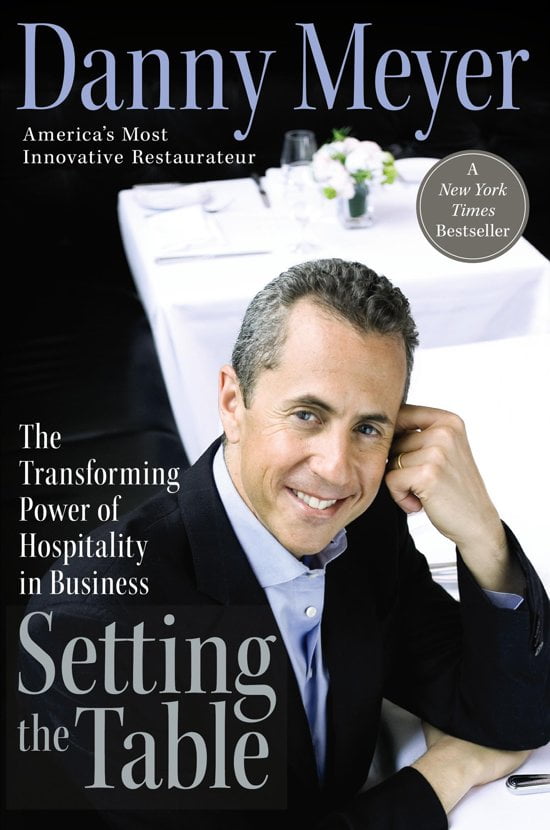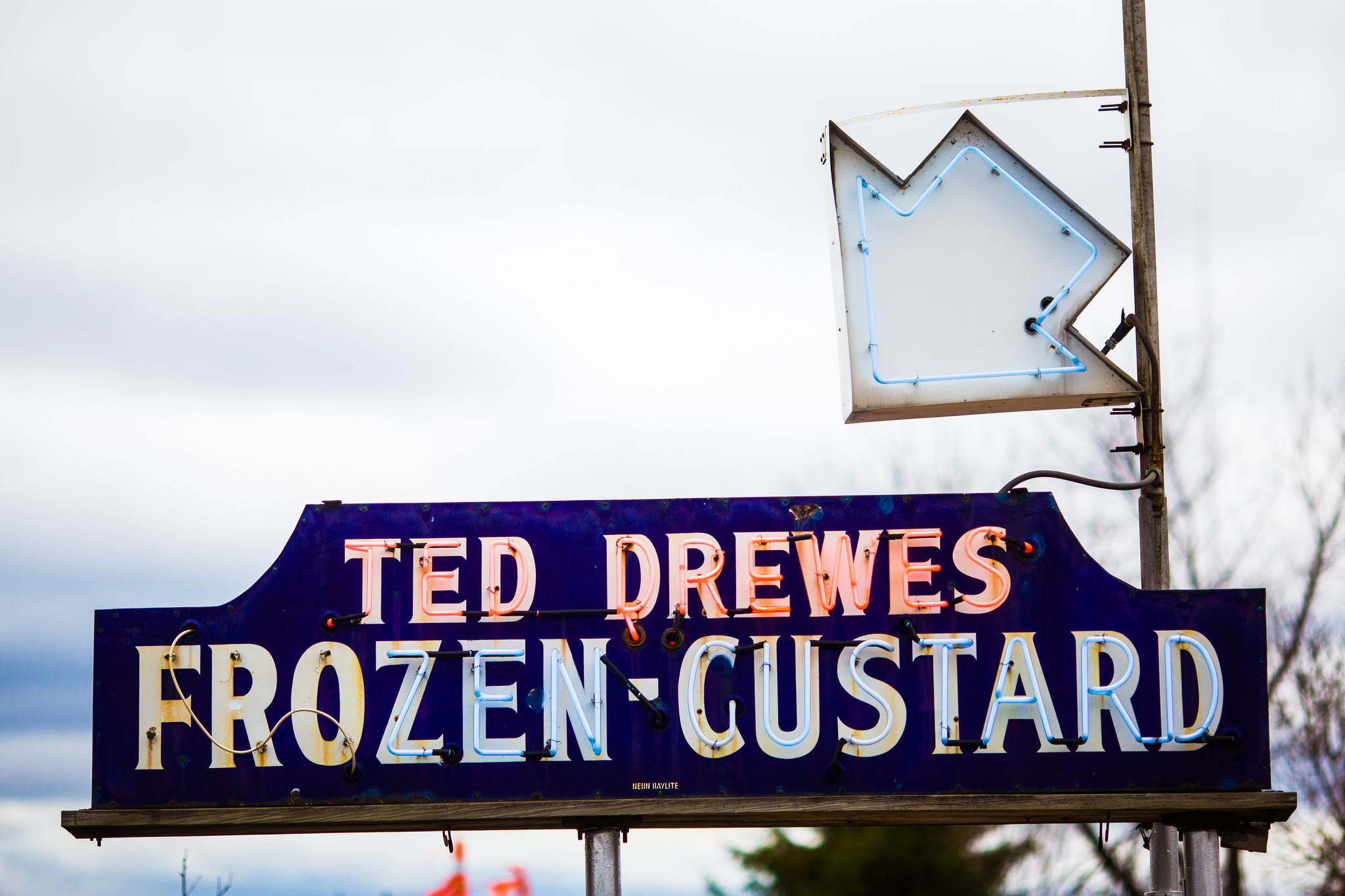Zojuist klapte ik Setting the Table van Danny Meyer dicht.
Dat boek gaat over gastvrijheid in restaurants, maar ik trof er tal van lessen voor de journalistiek en ondernemen in aan. Die deel ik hieronder.
Maar eerst: wie is Danny Meyer?
Een restaurateur die in New York wereldberoemd is, maar in Nederland kent vrijwel niemand hem. Zijn speerpunt is gastvrijheid – in zijn restaurants moet het voelen alsof je bij vrienden eet.
Meyer kwam de afgelopen vijf jaar twee keer in het nieuws in Nederland: toen zijn hamburgerketen Shake Shack naar de beurs ging en toen hij begon met het afschaffen van fooien. Desondanks is zijn boek niet naar het Nederlands vertaald.

Ik ben door het boek fan geworden van Meyer. De afgelopen maanden at ik in zijn eerste restaurant Union Square Café (althans, de reïncarnatie daarvan), op mijn verjaardag bij zijn Blue Smoke barbecuerestaurant en, jawel, de Shake Shack. Daarnaast dronk ik koffie in Untitled en Daily Provisions.
Deze plekken zijn allemaal onderdeel van zijn Union Square Hospitality Group, een bedrijf met inmiddels duizenden werknemers en zestien etablissementen.
Maar het imperium begon met het jarenlang buffelen in een restaurantje aan Union Square. En over dat coming-of-age-verhaal gaat Setting the Table.
Hieronder volgen mijn notities. Ik heb ze uitgeschreven om ervoor te zorgen dat ik zijn managementlessen goed onthoud, en om jou aan te moedigen dit boek ook een kans te geven. Je hoeft er geen Amerikaanse onlinewinkel voor te zoeken, tot mijn verbazing verkoopt Bol.com de paperback ook.
Notities uit Setting the Table van Danny Meyer
Leiderschap
Op pagina 108 beschrijft Meyer dat je bij een groeiende start-up je leiderschapsstijl op een bepaald moment moet aanpassen:
I managed by example, and I had yet to learn how critically important it is to lead by teaching, setting priorities, and holding people accountable.
En op pagina 110:
What had once been intuition – ripples I’d leave in my wake – could now be transformed into intentional waves.
Ik streef er zelf ook naar om mijn leiderschapsstijl op die manier aan te passen (heel moeilijk, kost veel tijd en aanhoudende aandacht).
Op pagina 139 schrijft hij:
The only way a company can grow, stay true to its soul, and remain consistently successful is to attract, hire, and keep great people.
Fair enough, hoe doe je dat?
Op pagina 140:
De ‘excellence reflex’: probeer in alles wat je doet – tot het schrijven van je mailtjes aan toe – zorgvuldig te zijn.
En:
We searched high and low for the rare employees who love teaching, know how to set priorities, work with a sense of urgency, and -most important-are comfortable with holding people accountable to high standards while letting them hold onto their own dignity.
Soms houd ik mijn mond als iemand niet aan hoge standaarden voldoet. Dat is eigenlijk oneerlijk – want zo bied je iemand niet de mogelijkheid om te leren.
I care enough about you to tell you the truth, even if the truth is tough to hear.
(pagina 214)
En op pagina 187:
Three hallmarks of effective leadership are to provide a clear vision for your business so that your employees know where you’re taking them; to hold people accountable for consistent standards of excellence; and to communicate a well-defined set of cultural priorities and nonnegotiable values. Perhaps most important, true leaders hold themselves accountable for conducting business in the same manner in which they’ve asked their team to perform.
Stel jezelf als manager telkens deze vraag:
Why would anyone want to be led by me?
Hoge standaarden: een zoutvaatje
Over die hoge standaarden….
Dit vertelde steakhouse-fenomeen Pat Cetta ooit aan Danny Meyer: als ondernemer heb je een bepaald idee voor je bedrijf. Het is als een zoutvaatje, dat je keurig midden op tafel zet. Maar je klanten en je medewerkers verschuiven door hun acties dat zoutvaatje telkens:
“It’s not your job to be upset. You just need to understand: that’s what they do. Your job is just to move the shaker back each time and let them know exactly what you stand for. Let them know what excellence looks like to you. And if you’re ever willing to let them decide where the center is, then I want you to give them the keys to the store. Just give away the fuckin’ restaurant!”
Goede communicatie: kikkers op een lelieblad
Op pagina 192 schrijft Meyer, zeer herkenbaar:
“We need to communicate more effectively”. I admit that for many years , I didn’t really know what this meant. I had no problem standing up in front of a group to give a talk. I thought I was a pretty good communicator, but then it dawned on me: communicating has as much to do with context as it does with content.
En:
Understanding who needs to know what, when people need to know it, and why, and then presenting that information in an entirely comprehensible way is a sine qua non of great leadership.
Je medewerkers zijn als kikkers op een lelieblad. Als jij opeens een grote steen in het water pleurt, vallen de kikkers van het blad:
“You did not give me advance warning or input about that decision you made. By the time I learned about it, the decision had already happened to me, and I was unprepared.”
Maar als je het aankondigt….
If only the frogs had had some warning about the impending rock toss, each one could have timed its jump so that the wave would have had no serious impact.
En:
Poor communication is taking away people’s feeling of control.
En:
Any company that thrives on a steady flow of creative ideas needs correspondingly strong communications.
Aannemen nieuw personeel
Op pagina 148 staan drie stevige vragen om jezelf te stellen wanneer je iemand aanneemt:
- Denk aan een dierbare die een goede bullshit detector heeft. Stel dat je met die persoon een diner hebt met de kandidaat, wat zegt die dierbare dan aan het einde van de avond? ‘What the hell were you thinking’ of ‘Hire that person immediately’.
- Zou je het erg vinden als de kandidaat voor je grootste concurrent ging werken? Of zou je stiekem opgelucht zijn?
- Denk aan de mensen wiens oordeel je ontzettend belangrijk vindt. Meyers voorbeeld: een kritische vaste gast of restaurantrecensent. Wat zou je ervan vinden als die persoon in aanraking kwam met het werk van de kandidaat?
En nog een bonusvraag op pagina 150:
Finally, I ask our managers to weigh one other critical factor as they handicap the prospect. Do they believe the candidate has the capacity to become one of the top three performers on our team in his or her job category? If people cannot ever develop into one of our top three cooks […], why would we hire them?
En ontslaan
Op pagina 144:
When an employee does not work out, the problem more often stems from an attitude of “I won’t” rather than “I can’t”.
Notities maken
Op pagina 38 beschrijft Meyer hoe hij het idee voor zijn eerste restaurant Union Square Cafe vormde door het maken van notities tijdens een lange reis door Europa:
Everywhere, I scrutinized menus and analyzed restaurant design. I scribbled in my journal, chronicling and decoding every component that defined the distinctive allure of a trattoria or ristorante.
Beyond describing dishes I had loved, the journal entries included notes and sketches for lightning fixtures, menus, architecture, flooring, and seating plans, and -tellingly- notes about how I felt treated wherever I slept or dined. I was developing my vision of my future restaurant by getting to know myself. Never before had I been alone for so long, and the experience was forcing and allowing me to think about and feel what truly mattered to me.
En op pagina 42:
My flight home from Rome was a scribble-fest. There were barely enough minutes within the eight-and-a-half hours for all the notes I was making on my time in Europe, and my plans for New York.
Deze passages doet me aan twee dingen dingen:
- Het belang van systematisch notities maken en hoe je daardoor groeit als mens. Daarover schreef ik eerder dit artikel over: maak je dromen waar, maak notities.
- Het belang van meerdere dagen alleen zijn om na te denken over wat je wilt. Dat advies gaf Tony Crabbe me ooit ook.
In 2011 gaf Steve Jobs een beroemde afstudeerspeech waarin hij benadrukte hoe belangrijk het was om ‘dots’ te verzamelen en die te ‘connecten’. Vijf jaar eerder wijdde Meyer hier al een heel hoofdstuk aan. Hij heeft het over ABCD: always be collecting dots. Verzamel systematisch informatie, ook als het niet direct relevant lijkt. Vrij vertaald: kijk verder dan je neus lang is. Weet je wie er in je restaurants zitten? Doe je onderzoek naar je gasten? En hoe gebruik je die kennis om hun ervaring te verbeteren?
Gastvrijheid
Voor Meyer lijkt dit leidend: het vergroten van return business en word of mouth marketing door excellente gastvrijheid. Die gastvrijheid kan betekenen dat hij heel veel interesse toont, of hele goede service verleent, maar bijvoorbeeld ook door gul te zijn. Sleutel is om de verwachtingen van mensen te overtreffen (zie bijvoorbeeld de ‘eggs daffodil’ anekdote op pagina 95).
Op pagina 90 omschrijft Meyer hoe hij over de schaalbaarheid van gastvrijheid denkt:
I want to hear [from our guests, EJP]: “We love your restaurant, we adore the food, but your people are what we treasure most about being here.” That’s the reaction that makes me most proud and tells me we’re succeeding on all levels. I encourage each manager to take ten minutes a day to make three gestures that exceed expectations and take a special interest in our guests. That translates into 1,000 such gestures every year, multiplied by over 100 outstanding managers throughout our restaurants. For any business owner, that can add up to a lot of repeat business.
Bedrijven die ik bewonder om wat ze aanbieden, zijn vaak bedrijven die obsessief bezig zijn met klantenervaring en telkens verbeteringen op dat vlak doorvoeren. Zoals Union Square Group. Of Amazon, dat’the world’s most customer-centric company’ probeert te zijn. Ik probeer mezelf er altijd aan te herinneren vanuit de klant te denken, en organiseer soms sessies rond de vraag: ‘Hoe kan ik als ondernemer meer customer-centric worden?’ Hoe kan ik met die bril naar bijvoorbeeld De Correspondent kijken?
Op pagina 92 deelt hij een les van wijlen make-up-mogul Mary Kay Ash voor verkopers: iedereen heeft een onzichtbaar bord om hun nek hangen met daarop ‘Make me feel important’. Hoe ga je daarmee om?
Kritiek krijgen
Op pagina 182:
A mark of a champion is to welcome scrutiny, persevere, perform beyond expectations, and provide an exceptional product – for which forgiveness is not necessary.
En op pagina 186: je bent nooit zo goed als mensen zeggen en tegelijkertijd ook nooit zo slecht. Stay centered.
Op pagina 216:
You need to surround yourself with a team of people who will mirror your integrity but complement and compensate for your strengths and weaknesses.
Nieuwe ideeën
Op pagina 99 schrijft Meyer:
I have never relied on or been interested in market analysis to create a new business model. I am my own test market. I am far more intuitive than analytical. If I sense an opportunity to reframe something I’m passionately interested in, I give it my absolute best shot.
Ondernemen
Op pagina 138 schrijft Meyer over Shake Shack, wat toen nog gewoon een hotdogtentje in een vervallen park was. Doel van Shake Shack was – naast winst maken – ook om het park op te lappen:
Shake Shack became not just a huge success but also a wonderful business model. Because a percentage of every sale becomes rent, paid both to the conservancy and to the city, every hot dog, burger, frozen custard, or beverage purchased and enjoyed by a guest contributes something to the park’s ongoing vitality. Shake Shack is a useful example of a for-profit entity whose success contributes monetarily and programmatically to the community. It shows that you can do well by doing good.
Aan het park huist tegenwoordig ook het beste restaurant ter wereld: Eleven Madison Park. Drie keer raden wie dat heeft opgericht.
Als je als bedrijf wilt groeien: heb je genoeg ‘key employees’ die die groei kunnen dragen (p.273)? Wat is je ‘people depth’?
Als een bedrijf even wat minder gaat
Stel, een restaurant raakt steeds leger. Hoe ga je daarmee om? Op pagina 210:
If you want to be busy, especially in times of scarcity and uncertainty, you can’t accept diminished standards of excellence in even one area. You do everything you possibly can afford to show your staff and guests that you care deeply about improving. [..] Investing money, imagination, and hard work to create a mind-set of abundance achieves abundance.
Tegeltje over fouten maken op pagina 220:
The road to success is paved with mistakes well-handled.
En als je een fout maakt: gebeurd is gebeurd. Wat ga je er vervolgens aan doen? “If a mistake is made, write a great last chapter.” Hij beschrijft op pagina 222 hoe je door een combinatie van kwetsbaarheid en gulheid fouten kunt proberen goed te maken.
En een lekkere afsluiter

Voor in mijn Evernote-mapje ‘Plekken om te bezoeken’, dit zijn de shacks die Danny Meyer bezocht voor zijn onderzoek voor Shake Shack.
- Ted Drewes – St. Louis
- Steak ‘n’ Shake – St. Louis
- Sheridan’s – Kansas City
- Culver’s – Michigan
- In-n-Out Burger – LA
- Taylor’s Automatic Refresher – Napa
- Gold Coast Dogs – Chicago
- Super Duper Weenie – Conneticut
- Clamps – Conneticut
- Sycamore Drive-In – Conneticut
Elke maand stuur ik mijn vrienden welke boeken ik gelezen heb. Wil je meelezen? Geef je hier op.

